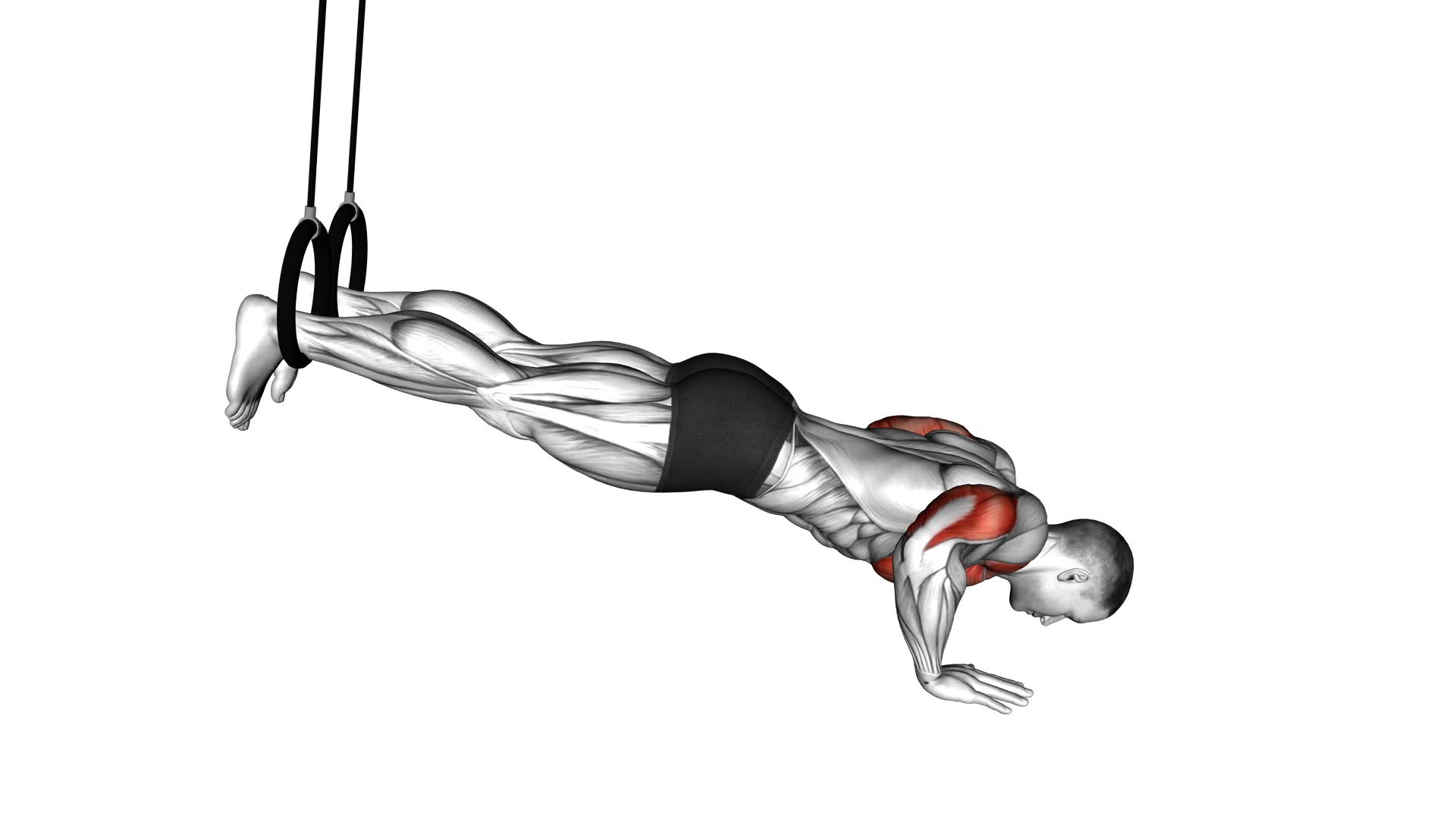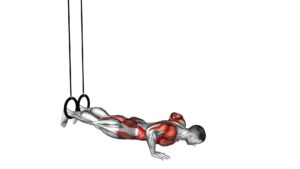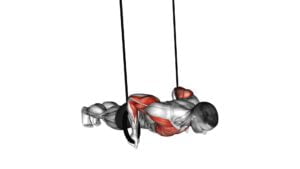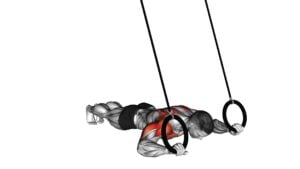Ring Decline Push-up (male) – Video Exercise Guide & Tips

Are you looking to level up your push-up game? Then the Ring Decline Push-up is the exercise for you.
Watch This Exercise Video
This video exercise guide and tips will show you the proper form and technique, progressions and modifications, and common mistakes to avoid.
Plus, we'll give you expert tips on how to increase the difficulty.
Get ready to incorporate the Ring Decline Push-up into your workout routine and take your upper body strength to new heights.
Let's get started!
Key Takeaways
- The ring decline push-up targets the chest, shoulders, and triceps while engaging core muscles and improving upper body strength and stability.
- There are various variations of the ring decline push-up, including different hand positions, adding pauses or tempo changes, and adjusting ring height or hand placement width to target specific muscles.
- Proper form and technique for the ring decline push-up include placing hands shoulder-width apart on the rings, positioning feet on a stable elevated surface, maintaining a straight line from head to heels, and pushing through the chest, shoulders, and triceps to extend the arms.
- Progressions and modifications for the ring decline push-up include elevating feet on a higher surface, performing the push-up with one leg lifted or wider hand placement, and using knees on the ground or hands on an elevated surface for support.
Benefits of the Ring Decline Push-up
The ring decline push-up offers a multitude of benefits for anyone looking to strengthen their upper body and core muscles. This challenging exercise not only targets the chest, shoulders, and triceps like a regular push-up, but also engages the core muscles to a higher degree due to the unstable nature of the rings. By performing this exercise, you can improve your overall upper body strength and stability.
One of the main benefits of the ring decline push-up is that it allows for a greater range of motion compared to a traditional push-up. The rings provide more freedom of movement, allowing you to go deeper and engage the muscles more effectively. This can lead to increased muscle activation and growth.
Another benefit of the ring decline push-up is the variety of variations that can be performed. You can adjust the height of the rings to target different muscle groups. For example, placing the rings lower will emphasize the chest muscles, while raising them higher will target the shoulders and triceps more. Additionally, you can also vary the width of your hand placement to further emphasize different muscles.
Proper Form and Technique
To perform the ring decline push-up with proper form and technique, you need to focus on maintaining a strong and stable core throughout the exercise. Here are some key tips to help you execute this exercise correctly:
- Keep your hands placed on the rings shoulder-width apart.
- Position your feet on a stable elevated surface, such as a bench or box.
- Lower your body by bending your elbows, ensuring they track along your sides.
- Maintain a straight line from your head to your heels throughout the movement.
- Push through your chest, shoulders, and triceps to extend your arms and return to the starting position.
By following these guidelines, you can maximize the benefits of the ring decline push-up and avoid common form mistakes. Remember, proper form is crucial for preventing injuries and getting the most out of your workout.
There are also variations of the ring decline push-up that you can try to add variety and challenge to your routine. These include:
- Utilizing different hand positions, such as wide or narrow grip.
- Adding pauses at the bottom or top of the movement.
- Incorporating tempo changes, such as slowing down the lowering phase or exploding up during the pushing phase.
Experiment with these variations to keep your workouts fresh and continue progressing towards your fitness goals.
Progressions and Modifications
Now, let's explore how you can progress and modify the ring decline push-up to continue challenging your strength and fitness levels.
There are several progression variations that you can incorporate into your routine to make the exercise more challenging. One effective progression is to elevate your feet on a higher surface, such as a bench or step. This increases the difficulty by placing more weight on your upper body.
Another progression is to perform the push-up with one leg lifted off the ground, engaging your core and increasing the demand on your upper body muscles.
You can also try performing the push-up with a wider hand placement, which targets your chest muscles to a greater extent.
If you find that the ring decline push-up is too challenging, there are also effective modifications that you can try.
One modification is to perform the push-up with your knees on the ground. This reduces the amount of weight you have to lift and allows you to focus on maintaining proper form and engaging your muscles.
Another modification is to perform the push-up with your hands placed on an elevated surface, such as a step or a bench. This decreases the amount of weight you have to lift and allows you to gradually build up your strength.
Remember to listen to your body and choose a progression or modification that suits your current fitness level.
Common Mistakes to Avoid
When performing the ring decline push-up, it's important to avoid common mistakes that can hinder your progress.
One common mistake is incorrect hand placement, which can put unnecessary strain on your wrists and shoulders.
Another mistake to avoid is improper body alignment, such as sagging or arching your back, which can lead to ineffective results.
Lastly, make sure to engage your core muscles throughout the exercise to maximize its benefits and prevent injury.
Incorrect Hand Placement
Avoid placing your hands too close together or too far apart when performing the ring decline push-up. Incorrect hand placement can lead to wrist pain and decrease the effectiveness of the exercise. Here are some common mistakes to avoid:
- Placing your hands too close together: This can put excessive strain on your wrists and limit your range of motion.
- Placing your hands too far apart: This can cause instability and make it difficult to maintain proper form.
- Not aligning your hands with your shoulders: Your hands should be directly under your shoulders for optimal stability and control.
- Gripping the rings too tightly: This can strain your wrists and forearms. Instead, maintain a firm but relaxed grip.
- Allowing your wrists to collapse: Keep your wrists strong and straight throughout the movement to prevent pain and injury.
Improper Body Alignment
To maintain proper form and avoid potential injuries, it's important to focus on maintaining proper body alignment during the ring decline push-up.
Proper body alignment ensures that you engage your core effectively and distribute the workload evenly throughout your body. Start by aligning your wrists directly under your shoulders and keeping your elbows slightly bent.
Your body should form a straight line from your head to your heels, with your core activated and engaged throughout the movement. Avoid sagging your hips or letting them rise too high, as this can put unnecessary strain on your lower back.
By maintaining proper body alignment, you can optimize your performance and reduce the risk of injuries.
Now, let's move on to the next section and discuss the importance of engaging your core during the ring decline push-up.
Lack of Core Engagement
Ensure proper engagement of your core during the ring decline push-up to maximize the effectiveness of the exercise and prevent potential mistakes. To achieve optimal core stability and muscle activation, keep the following in mind:
- Maintain a neutral spine throughout the movement, avoiding excessive arching or rounding of your back.
- Focus on squeezing your abdominal muscles and bracing your core to provide stability and support.
- Keep your hips in line with your shoulders, avoiding any sagging or piking.
- Engage your glutes to help stabilize your pelvis and maintain proper alignment.
- Breathe deeply and exhale as you push up, engaging your core even more.
By ensuring proper core engagement, you won't only enhance the effectiveness of the ring decline push-up but also reduce the risk of injury.
Now, let's move on to the next section and explore tips for increasing the difficulty of this exercise.
Tips for Increasing Difficulty
To increase the difficulty of the ring decline push-up, you can incorporate progressive overload techniques. This means gradually increasing the intensity or resistance of the exercise over time.
You can also modify the equipment used, such as using gymnastic rings or placing your feet on an elevated surface, to challenge your muscles in new ways.
Progressive Overload Techniques
To increase the difficulty of the Ring Decline Push-up exercise, incorporate progressive overload techniques. These techniques will challenge your muscles and help you make consistent gains in strength and endurance. Here are some advanced variations and overload progressions to try:
- Elevate your feet on a higher surface, such as a bench or box, to increase the decline angle and engage your upper chest and shoulders even more.
- Use resistance bands or weighted vests to add extra resistance and make the exercise more challenging.
- Experiment with different hand positions, such as placing your hands closer together or wider apart, to target different muscles.
- Try performing slow and controlled repetitions, focusing on the eccentric (lowering) phase to increase time under tension and build muscle.
- Incorporate plyometric variations, such as explosive clap push-ups or depth push-ups, to further challenge your upper body power and explosiveness.
Equipment Modifications for Advancement
To increase the difficulty of the Ring Decline Push-up exercise, you can modify the equipment. There are several equipment modifications and advanced variations that you can try to challenge yourself even further.
One option is to use gymnastic rings with adjustable straps. By setting the rings lower to the ground, you increase the decline angle and put more emphasis on your upper chest and shoulders.
Another modification is to use weighted vests or ankle weights to add extra resistance to the exercise. This will make your muscles work harder and promote strength gains.
Additionally, you can incorporate unstable surfaces like a Bosu ball or a stability disc to engage your core muscles and improve balance and stability.
These equipment modifications will take your Ring Decline Push-ups to the next level and help you achieve greater strength and muscle development.
Now, let's explore how to incorporate the ring decline push-up into your workout routine.
Incorporating the Ring Decline Push-Up Into Your Workout Routine
Incorporate the Ring Decline Push-Up into your workout routine by utilizing proper form and gradually increasing the difficulty level. This exercise variation can help you activate multiple muscle groups while adding variety to your routine. Here are some tips to help you incorporate the Ring Decline Push-Up effectively:
- Start with the basic Ring Decline Push-Up: Begin by setting up the rings at a height that allows you to maintain proper form. Place your feet on a raised surface, like a bench or box, and grip the rings with your hands. Lower your chest towards the rings, keeping your body in a straight line, and then push back up to the starting position.
- Increase the difficulty: Once you have mastered the basic Ring Decline Push-Up, you can make it more challenging by raising the height of the rings or using a weighted vest.
- Combine with other exercises: Include the Ring Decline Push-Up in a circuit or superset with other upper body exercises, such as pull-ups or dips, to target different muscle groups.
- Adjust the tempo: Experiment with different tempos, such as slowing down the lowering phase or pausing at the bottom, to further engage your muscles.
- Track your progress: Keep a record of your sets, reps, and any modifications you make to ensure progressive overload and monitor your improvement over time.
Frequently Asked Questions
How Many Reps and Sets Should I Do for the Ring Decline Push-Up?
For the ring decline push-up, it's important to consider your fitness level and goals. Start with 3 sets of 8-10 reps and gradually increase as you get stronger.
This exercise targets your chest, shoulders, and triceps while also engaging your core for stability.
Ring training offers unique benefits such as improved balance, stability, and increased muscle activation.
Incorporating ring decline push-up variations into your routine can help enhance overall upper body strength and muscle definition.
What Muscles Does the Ring Decline Push-Up Target?
The ring decline push-up is a challenging exercise that targets multiple muscles in your upper body. By performing this variation of the push-up on rings, you engage your chest, shoulders, triceps, and core muscles.
Ring training adds an element of instability, which forces your muscles to work harder to stabilize your body. This can lead to increased strength, muscle definition, and improved overall fitness.
Incorporating ring decline push-ups into your routine can provide a unique and effective way to train your upper body.
Can the Ring Decline Push-Up Help With Building Upper Body Strength?
Incorporating the ring decline push-up into your workout routine can definitely help you build upper body strength. This exercise targets your chest, shoulders, triceps, and core muscles. By using the rings, you engage more stabilizer muscles, which increases the intensity of the exercise.
Additionally, there are variations of push-ups that can target different muscle groups such as the diamond push-up for triceps and the wide grip push-up for chest.
Is It Safe to Perform the Ring Decline Push-Up if I Have a Shoulder Injury?
If you have a shoulder injury, it's important to prioritize safety when it comes to exercise.
While the ring decline push-up can be beneficial for building upper body strength, it may not be safe for you in this situation.
Instead, consider modifying the exercise or finding alternative exercises that put less strain on the shoulder joint.
Consulting with a healthcare professional or a qualified trainer can help you determine the best approach for your specific needs.
Can Beginners Perform the Ring Decline Push-Up or Is It More Suitable for Advanced Individuals?
Beginners can certainly perform the ring decline push-up, but it's more suitable for advanced individuals. If you're a beginner, there are modifications you can make to make it easier, such as performing the exercise with your feet on the ground instead of on the rings.
This exercise offers great benefits for advanced individuals, such as increased upper body strength and stability. However, make sure to consult with a fitness professional if you have any concerns or injuries.
Conclusion
Incorporating the ring decline push-up into your workout routine can provide numerous benefits, including increased upper body strength and stability. By maintaining proper form and technique, progressing gradually, and avoiding common mistakes, you can maximize the effectiveness of this exercise.
Additionally, by following the tips for increasing difficulty, you can continue to challenge yourself and see continued progress.
So, why not give the ring decline push-up a try and take your fitness to the next level?

Author
Years ago, the spark of my life’s passion ignited in my mind the moment I stepped into the local gym for the first time. The inaugural bead of perspiration, the initial endeavor, the very first surge of endorphins, and a sense of pride that washed over me post-workout marked the beginning of my deep-seated interest in strength sports, fitness, and sports nutrition. This very curiosity blossomed rapidly into a profound fascination, propelling me to earn a Master’s degree in Physical Education from the Academy of Physical Education in Krakow, followed by a Sports Manager diploma from the Jagiellonian University. My journey of growth led me to gain more specialized qualifications, such as being a certified personal trainer with a focus on sports dietetics, a lifeguard, and an instructor for wellness and corrective gymnastics. Theoretical knowledge paired seamlessly with practical experience, reinforcing my belief that the transformation of individuals under my guidance was also a reflection of my personal growth. This belief holds true even today. Each day, I strive to push the boundaries and explore new realms. These realms gently elevate me to greater heights. The unique combination of passion for my field and the continuous quest for growth fuels my drive to break new ground.







